

Tom Keller talked to Danish singer-guitarist, music journalist and promoter about life with traditional and experimental music, Danish music radio and the world in general …
Hei Morten! How did you come to music and how did you end up playing traditional music in particular?
I was born in 1961, and when I was a kid, I lived with my family in the southern part of Denmark, not far from Rødby, where the ferry between Rødby and Puttgarden goes.
My father, Fin Alfred Larsen (born in ‘39), was - and still is - a musician and tradition carrier. He plays accordion, banjo, and a lot of other instruments, and he has a huge repertoire of tunes from Denmark and all over Europe. He also knows a lot of old songs from Denmark - joking songs, working songs, soldier songs, farmer songs, political songs, naughty songs, and so on.
My father was very active as a young man during the fifties, singing, playing and dancing in a youth ensemble called “Tinguti”, after an old Danish joking song, and he was traveling all over Europe with his friends in this ensembles, performing, but also collecting traditional music and dances.
During the sixties and the seventies, he and some of his friends from Tingluti, created a series of learning books full of European dance tunes and songs, illustrated and with cords written above the music These books made it easy for people to learn to sing, dance and play together. The books has sold more than two million copies, and are still used for teaching in Danish schools and other teaching institutions.
So I grew up in a home with a lot of music, and that was, of course, very inspiring for me. My room was right under my father’s workshop upstairs, so every night I listened to traditional music from all over the world.
But when I was nine years old, my parents got divorced, and my father moved to Copenhagen, to play music.
For me the music became a nice way to stay in touch with my father, I ‘stole’ my mother’s acoustic Oscar Teller-guitar, and when I was about 16 years old, I joined my fathers dance band. During almost 20 years, we played a lot of especially dances, playing at weddings, harvest parties, family parties, political meetings, and for whoever wanted us, actually.
The repertoire was a blend of traditional Danish music and songs, well known, and lesser known schlagers, and whatever people wanted to hear. We arranged our music for piano accordion (My father), double bass, drums, saxophone, acoustic guitar (me), vocals, and often with some very cool guest musicians joining the band, playing for example bouzouki, electric guitar, saxophone, washboard, banjo, flutes or maybe violin or two row accordion or so.
Our music and sound was flowing freely, always changing, and during the years heavily inspired by sometimes skiffle and jazz, sometimes Cajun and zydeco, and so on, acoustic funk and rock, colored by what ever came our way – including the Greek master Theodorakis’ music, German tunes, Swedish songs and so on. We didn’t care, as long as we had a good time, and our audience was dancing and happy.
But underneath it all was the traditional Danish music, especially the Danish songs that my father had been collecting since he was a boy living in the working class neighborhood in Copenhagen.
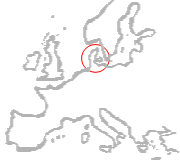
Danish traditional music (Danish: spillemandsmusik) is the music genre that has its roots in pre-modern Denmark. In this period it was common for towns to have one or more town musicians (Danish: spillemand) who played at dances, processions and certain rituals. In the 17th and 18th centuries, professional music performances were monopolized by town musicians, who also traveled into the neighboring rural areas to perform. Urban music and dance styles, often from other parts of Europe, penetrated the countryside and almost eradicated earlier styles. This period also saw the introduction of the fiddle as the most important instrument and the abandonment of earlier chain dances in favor of pair dances. Until around 1900, traditional music was the common musical culture of Denmark, but with increasing urbanization and the spread of classical music it became marginalized to rural areas.[1]

Through the Middle Ages and into the 19th century there are reports of "chain dances", processions and ceremonial dances accompanied by pipes, drums and singing.
In the 17th and 18th centuries, throughout Denmark the practice of music was under the monopoly of the appointed city musicians (stadsmusikant), who with their journeymen and apprentices were the only musicians allowed to play for a salary within an assigned territory. Since the city musician was trained in the cities, this meant that courtly repertoires made their way into the countryside, and that most areas did not maintain local musical traditions during this time. Only a few areas, such as Bornholm and Amager, never had the stadsmusikant monopoly, and a few others such as Fanø maintained a local tradition by an arrangement whereby local musicians leased the right to perform on the island from the city musician of Ribe. Since city musicians frowned on the use of instruments deemed impure such as drums, bagpipes and hurdy gurdies, this period also saw the rise of the fiddle as the main instrument for dance music.[2]
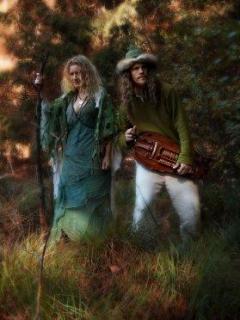
From around 1500, medieval chain dances were displaced by pair dances. The oldest known pair dance in Denmark is the pols, an adapted variant of a Polish dance that was popular in Sweden as early as the 16th century. It is assumed that the pols was prevalent in the Danish countryside by the second half of the 17th century, and in the 18th century it was the most common popular dance along with the minuet. These Polish dances were usually performed in two parts: a slow march and a faster 3/4 second part. Often in the oldest hand-written tune books only the first part was written, as the fiddler improvised the second half based on the first.
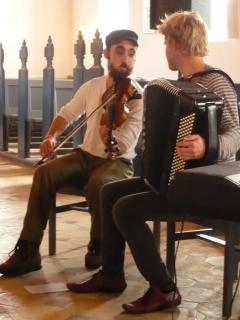
From the end of the 18th century English-style contra and square dances became popular. In the 19th century the waltz became the most popular dance in the cities, after having been known in the countryside for a while. Other dance types of the early 19th century are hopsa, rheinlænder, galop, sveitrit and schottish all of which were integrated into the popular English style dances, and later developed their own local dance forms. Around 1850 the polka and mazurka entered the popular repertoire. At the end of the 19th century the earlier dance tradition began to lose its place to modern dances from England, Southern Europe and America.[3]
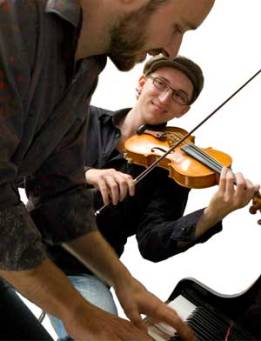
To counter the loss of traditional dances, the Association for the Promotion of Folkdancing was founded in 1901, focusing on the preservation of popular dances from the period 1750-1850. Many local chapters of such preservation societies appeared during the first decades of the 20th century, and in 1929 there were as many as 16,000 members. These dance associations had a homogenizing effect on the popular dances, creating a standard repertoire of Danish folk dances. They often danced in folk dress. In response to this homogenizing effect of the folkdancing guilds, informal dance organizations working to keep local dance traditions alive in informal settings were also developed, under the name of "Old Dance". Certain rural areas of Denmark such as Fanø, Læsø, Ærø and parts of Western Jutland maintained living traditions of dancing from the late 18th century well into the 20th century.[2][4]

The earliest known Danish traditional music comes from the handwritten tune collections of musicians, such as the large collection of tunes by Rasmus Storm (ca. 1760). Collection of Danish folkmelodies began in the early 19th century, and figures such as Svend Grundtvig (1824–83), A. P. Berggreen (1801-80) and Evald Tang Kristensen (1843-1929) published significant collections of tunes and songs. In the early 20th century with the establishment of the field of ethnology in Denmark, the collection of folk tradition including music, song, and dances began in earnest.[5]
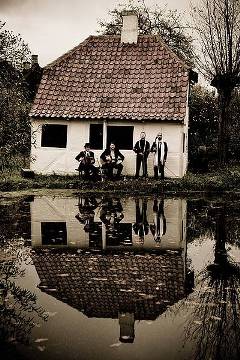
When I was about 20 in the beginning of the eighties, now living in Copenhagen, I met the strong Irish music scene that was growing in the city at the time, and I was fascinated by the idea of taking traditional dance music on the stage arranging it and using it for concert music. And I also started to compose music by myself.
I got involved with a gang of young Danish musicians playing French-Canadian music in Denmark and Scandinavia, and then I met the great American fiddle player, Ruthie Dornfeld, who was on tour with American old-time music in Denmark, and we decided that I should come to Boston. Ruthie and some of her good friends booked a month long tour on the American east coast, where we played mostly American, Irish, Scottish and French-Canadian music, and we created the trio, American Café Orchestra, playing a mix of Celtic, American, French-Canadian and Scandinavian music. The trio played a lot of tours in Scandinavia and the US, and eventually we started to compose our own music as well. Nowadays we only play our own music, when we meet.
During the eighties and nineties, I traveled, played and composed with great musicans from around the world; the American fiddler, Ruthie Dornfeld, the American mandolin player and guitarist, John McGann, the Swedish harmonica player and singer, Pelle Lindström, the Finnish jaws harp player, flutist and bass player, Tapani Varis, the French-Canadian accordion player, Raynald Ouellet, the French-Canadian stepdancer, Benoit Bourque, and many more
And then of course a lot of great Danish musicians, like accordionist Carl Erik Lundgaard, violinist Hans Jørgen Christensen, accordion player and harmonica player Sonnich Lydom, and saxophone player Hans Leonardo Pedersen and many more.
In the beginning of the nineties (1993) I met with the Danish accordionist, Carl Erik Lundgaard, at Tønder Festival, and we started the band Danish Dia Delight – it was time to get back to my Danish roots.
Then in 1998, I had a very special year. I got my first son, Sven Alfred, I released a solo album, Vingården/The Vinyard, and I started to play with the young Danish violinist, Harald Haugaard, with whom I composed and toured for 10 years from 1098 to 2008. We played traditional Danish music mixed with our own music, arranged for violin, guitar and vocals. We did about 1000 concerts all over Europe, USA, Canada, Australia and Japan, and we loved every minute of it.
You had a colourful musical career. Could you highlight the most important 'stations' on your musical journey!
My father was – and is – very important for my understanding of music, and I have learned from him to always be curious about all kind of music from all over the world. He used to feed me with all kind of stuff from Macedonian music, over French or Danish schlagers, to Frank Zappa and Bob Dylan. I still perform with him occasionally, in 2002 he received a Danish Music Award (Danish “Grammy”), for Ballad album of the Year, on which I also played.
The meeting with the Copenhagen-Irish and French-Canadian music scene was very inspiring, and meeting up with the American fiddler Ruthie Dornfeld, took me out in the world to play my music for the first time.
The French-Canadian accordionist, Raynald Ouellet, taught me something important about tradition and about being a travelling professional folk musican, and he was a lot of fun to play with.
Working with my friend, film editor, Jes Paul, for 20 years composing music for TV was great as well – it gave me the a good routine in composing music, and it was fun and paid my bills – and still does sometimes.
Working with Harald Haugaard became very important for me. I got to know my abilities when it come to communicating with an audience, and it taught me how I am not the important person during the concert, the audience is the important factor. If they don’t have a good time the whole thing doesn’t matter!
I also composed some good music together with Harald, and I learned how fantastic the duo format is. But also how demanding it is. There is nowhere to hide, you are in focus all the time. And I loved it!! But after ten years of traveling intensely, after seven albums in three countries, we needed to take care of our families and to do something different. But we did actually receive 7 Danish Music Awards (Danish “Grammy”), and I got one as Danish Folk Composer of the Year :o)
The friendship with saxophonist, Eskil Romme (Himmerland), has also been of great importance. He is a guy who makes things happen, and our discussions has sometimes been hard, but also rich and creative as we have to find new ways to get our music out to the world.
Right now I work in several bands, including the Danish folk/world band, Himmerland, that perform new music that we compose ourselves, as well as old Danish songs in new arrangements. We are a band of pretty different people from pretty different cultures (Denmark, Poland and Ghana), traditions, and genres (world, folk, trad, jazz, pop-rock and more) - and we are all in different places in our life. One of us has grown up kids, and is running a farm, one is traveling all the time with many bands living in a suitcase, another one have steady jobs and are just starting up families with little kids, one is a single father of two teenagers (that is me), and so on, but never the less, we are one of the most touring Danish folk acts, performing all over Europe and in Canada, Australia and New Zealand. We love to play our own music with our own sound, we just released our second album, “The Spider in the Fiddle”, and right now we have exact plans and concerts at least for the next couple of years.
Then I play in a band called Lydom, Bugge & Høirup, where we exclusively perform traditional Danish music and songs that we find in old books or learn from old tradition carriers. It is important for us to present a repertoire that nobody else plays. And that is fun, and we travel some as well – we are playing and teaching traditional Danish music at Festival of American Fiddle Tunes in Seattle area in the summer of 2015, and will be going to the US and Canada several during 2016, amongst others. We are releasing a new album in the summer 2015.
I also play with the Danish accordion and fiddle duo, Jensen & Bugge (Jensen & Bugge + Høirup), we will be releasing an album of music from the Danish “Musikdirektør” – musical director – Borcher Madsen who was born 200 years ago, in June 2015.
Besides playing music you were always actively promoting Danish folk music as a journalist etc. What have you done so far?
Well, when I grew up during the eighties and the nineties, it was not very hot or “smart” to play roots and folk music – musicians from other genres didn’t respect us very much, and the genre had a reputation as a genre where everybody, no matter how new they were on their instrument, could play along, a genre of pure amateurs.

Being deeply involved in tis music all my life, and making a huge part of my income with this music, it’s was – and it is - natural for me to identify with the touring musicians of roots and folk music, and I have done what I could to support my colleagues, and to promote and feature this fantastic music on the Danish Broadcasting Association (Danmarks Radio = DR) where I worked as a freelance for more than 20 years, and where ever I could.
I have worked as a project manager for Danish Roots – Growing in the World, an organization helping traveling Danish roots and folk musicians, supported by Danish composer and musician organisations, I have been fighting to keep Danish roots and folk music on the air by producing programs about the music and the musicans on different underground radio stations, I have produced one of the Danish Music Awards shows together with Harald Haugaard, and so on.
For the last five years I have been an elected member of the board of DJBFA (Danish Songwriters & Composers). We are working to promote, feature and support Danish composers, and I have been part of creating quite a few initiatives that supports composers, also roots and folk music composers.
And now it's the new Danish online radio station www.radiofolk.dk. What is it about?
When the Danish Folk Music Council went bankrupt a few years ago, the Danish folk music was suffering bad leadership and for a while we had only Danish Roots – Growing in the World as a lighthouse for the traveling musicians.
In 2013 ROSA (Danish Rock Council) took over the responsibility for the money coming from the state to Danish roots and folk music, for the next four years, until new decisions are made.
I was hired to work with project managing and communication, and one of my tasks was to start an online radio station, Radiofolk.dk, promoting and featuring Danish roots and folk music.
We don’t have much money, but we still think that it is a great idea.
For quite some time Danish Radio (DR) has not been very interesting in Danish roots, folk, world, blues, and so on, and we thought that there will be two Thursdays in one week before we get the roots and folk music back in Danmarks Radio (DR).
We think it is very important that you can find places to hear this music, and also it is important to document what great music is being created. Further more we think that a radio station like this is important since it keeps a genre and an environment around the music together, so to speak.
My job on the radio is to lead it, I am the chief editor, and I produce as many programs as I can, to keep a flow of news and music. Right now we have more than 6.000 titles on the server, we have a lot of music flowing, but also programs where you can learn about the music and the people playing it, with interviews, reports, live-recordings and much more.
I am also responsibly to involve more people, especially young people in producing shows about the music, and my job is also to find cheep ways to promote he program.
Further more we have a clear ambition about using this radio station to communicate to the whole world what a fantastic living scene of roots and folk music we have – not to mention all the great traditional musicians we have.
Already now, you can find programs in Danish and English, more are coming, and you can stream and stream on demand, and soon you can podcast as well!
I think that we have many assets when it come to our roots and folk music scene in Denmark: We have “Fire souls” working hardtop promote, feature and support the music and the people playing it. And we have:
… and much, much more. So in many ways I am very optimistic about the situation in Denmark!
Looking at the Danish folk music scene in 2015, which artists and groups would you especially recommend?
This is a hard one. I have noticed that many Danish bands has musicians from other countries playing. A good example is the duo, “Maja & David”, which is the Danish singer and violin player, Maja Kjær Jacobsen and the French Canadian violinist and percussionist, David Boulanger, from the French Canadian super band, La Bottine Souriantes.
Another interesting act is the Danish-Swedish act, Trolska Poslka, who are kind of setting the Swedish fairytale writer, Astrid Lindgrens Nordic world into music.
Habadekuk is a great Danish band splaying tricktly traditional tunes framed by a brass section and a rhythm group. They are a lot of fun.
Also Dreamers Circus’ and their blend of Nordic and classical music is worth to listen to.
Fromseier Hockings is a great violin and guitar duo.
…and there are so many more.
What's next? Any future plans for you?
Now a days I live in a nice little apartment in Frederiksberg, a part of Copenhagen, together with my two teenage sons, I travel with different bands and as a representative for the Danish roots and folk music, I work a lot to promote and develop Radiofolk.dk, and Danish Roots and folk music, and I am a member of the board in DJBFA, Denmark’s largest association for professional composers, and of the executive committee of the board.
I have lots of future plans: First of all to keep develop that radio station of mine.
In March I go two weeks to Australia with Himmerland, then we go to Finland, The Faroe Islands, England etc. In June we join the exclusive little organic food and international music festival, Hakær Festival, that Eskil from Himmerland (the band and also the name of an area of the North-eastern part of Jutland) is arranging. This is were we met as and started the band, about five years ago. I have been coming there for 20 years, and this year I am going to be the MC (conferencere).
In July 15, I release an album of traditional Danish music together with Lydom, Bugge & Høirup, and we go to perform and teach at the Festival of American Fiddle Tunes, and in June 15, I release another album, but this time with Jensen & Bugge + Høirup, an album of music composed by Musikdirektør Borcher Madsen, who was born 200 years ago.
In August Radiofolk.dk will be broadcasting from the little but great festival “Musik over Præstø Fjord” (www.folkemusik.com), and in the late August, we will broadcast direct from Tønder Festival.
… so there is a lot to do, and I also have to find time to compose some more music.
|
|
|
|
|
Photo Credits:
(1) Radiofolk.dk,
(2) Morten Alfred Høirup,
(3) Fin Alfred Larsen,
(4) Carl Erik Lundgaard,
(6) Krauka,
(7) Eskil Romme,
(8) Asynje,
(9) Himmerland,
(10) Hal & Nikolaj
(11) Jensen & Bugge,
(12) Rannok,
(13) Dreamers’ Circus,
(15) Basco,
(16) Trolska Polska,
(17) Fromseier Hockings,
(19) Maja & David
(unknown/website);
(5) Harald Haugaard
(by The Mollis);
(14) Svøbsk
(by Walkin' Tom);
(18) Habadekuk
(by Karsten Rube).